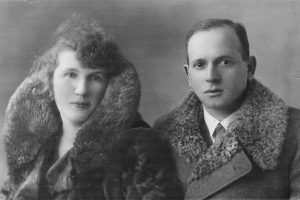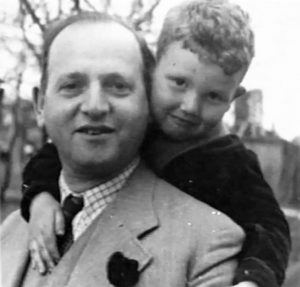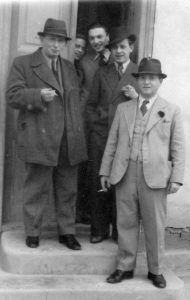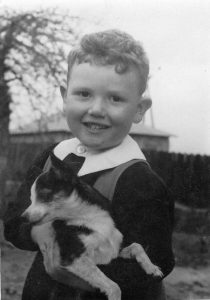– Text / Tekst in: Deutsch English Polski –
[DE] Israel (Srulek) Zygmunt Lippman war der Lieblingsonkel von Józef Lipman. Oft durfte der wissbegierige Józef seinem Onkel bei Zahnbehandlungen zusehen. Israel Lippman war verheiratet mit der aus Sambor stammenden Lusia, geb. Fischman. Ihr Sohn Tusio war vier Jahre jünger als Józef – oft spielten sie als Kinder zusammen. Alles änderte sich nach dem deutschen Überfall 1941. Einige Monate später wurde ein Ghetto in Boryslaw eingerichtet. Józef Lipman berichtet in seinen Erinnerungen:
read more / Czytaj więcej >
„In der Wohnung [im Ghetto] lebte außer uns dreien der Bruder meines Vaters, der Zahnarzt war, mit Frau und dem sehsjährigen Sohn. Er führte eine Zahnarztpraxis. Solange arische Patienten kommen konnten, ging es ihm gut. Sie bezahlten meist in Naturalien, also mit Lebensmitteln. Damit war Schluss, als das Ghetto eingerichtet wurde. Ich erinnere mich, als einmal ein Deutscher als Patient kam, er war Polizist bei der Reiterzugpolizei. Der Onkel kurierte ihm einige Zähne. Zum Schluss forderte der Deutsche, ihm Reithosen mit Lederbesatz zum Reiten nähen zu lassen. Sein Wunsch musste kostenlos erfüllt werden.“
Im Juni 1943 wurde das Ghetto ständig durchkämmt. Vorher hatten die Familien von Abraham Lippman und Israel Lippman in einer kleinen Wohnung im Ghetto zusammen gelebt. Diese Wohnung war relativ sicher, da Abraham Lippman ein gut getarntes Versteck eingebaut hatte. Als eine andere Wohnung im Ghetto leer stand, zogen Israel, Lusia und Tusio dorthin. Währenddessen versuchte die Familie von Lusia, für den kleinen blonden, sehr „arisch ausehenden“ Tusio in Krakau „arische Papiere“ zu bekommen. Als die Papiere endlich eintrafen, war es zu spät. Polizei und Miliz hatten das Ghetto druchkämmt und Lusia mit ihrem Sohn Tusio verhaftet. Einige Tage später wurden sie erschossen.
Danach verlor Israel Lippman jeden Lebenswillen. Für die Familie seines Bruders Abraham besorgte er ein Versteck gegen Bezahlung bei einer Bauernfamilie in Ratoszyn. Er hörte aber nicht auf die Bitten seines Bruders, sich selbst auch dort zu verstecken. Als das Zwangsarbeitslager in Boryslaw aufgelöst wurde, wurde er mit den anderen Juden in das KZ Plaszow transportiert. Vom KZ Plaszow wurde er am 10.8.1944 in das Außenlager Melk des KZ Mauthausen unter der Häftlingsnummer 87289 eingeliefert und musste dort im Steinbruch arbeiten. Die durchschnittliche Lebensdauer der Zwangsarbeiter dort betrug nur wenige Wochen. Am 17.11.1944 wird im Totenbuch sein Tod registriert – Todesursache „Kreislaufschwäche“. Das Archiv der Gedenkstätte Mauthausen schreibt dazu, dass die angegebenen Todesursachen „nicht mit den wirklichen Gründen für das Hinscheiden des Häftlings übereinstimmen“ müssen.
[EN] Israel (Zygmunt) Lippman was Józef Lipman’s favourite uncle. Often the inquisitive Józef was allowed to watch his uncle doing dental work. Israel Lippman was married to Lusia, née Fischman, who came from Sambor. Their son Tusio was four years younger than Józef – they often played together as children. Everything changed after the German invasion in 1941 and a few months later a ghetto was established in Boryslaw. Józef Lipman reports in his memoirs :
„Apart from the three of us some other persons lived in the flat [in the ghetto]: my father’s brother, a dentist, with his wife and their six-year-old son. My father’s brother ran a dentist’s office. As long as Aryan patients could come he was quite well off. They mostly paid in kind, i.e. in food stuff. That came to an end when the ghetto was established. I remember a German patient coming to the dentist’s; he was a policeman employed at the mounted police. My uncle gave him some dental treatment. In the end the German demanded that on top of his free treatment, he was also sown some horse riding pants with leather trimmings. His wish had to be fulfilled without any compensation.„
In June 1943 the ghetto was constantly raided. Previously, the families of Abraham Lippman and Israel Lippman had lived together in a small apartment in the ghetto. This apartment was relatively safe because Abraham Lippman had built a well-camouflaged hiding place. When another apartment in the ghetto was empty, Israel, Lusia and Tusio moved there. Meanwhile, Lusia’s family tried to get „Aryan papers“ for the little blond, very „Aryan-looking“ Tusio in Krakow. When the papers finally arrived, it was too late. Police and militia had combed the ghetto and arrested Lusia and her son Tusio. A few days later they were shot.
After that Israel Lippman lost all will to live. For the family of his brother Abraham, he found a hiding place with a peasant family in Ratoszyn for a fee. But he did not listen to his brother’s requests to hide himself there as well. When the forced labour camp in Boryslaw was closed down, he was transported with the other Jews to the Plaszow concentration camp. From Plaszow concentration camp he was transferred on 10.8.1944 to the Melk subcamp of Mauthausen concentration camp under prisoner number 87289, where he had to work in the quarry. The average lifespan of the forced labourers there was only a few weeks. On 17.11.1944 his death is recorded in the death register – cause of death „circulatory weakness“. The archive of the Mauthausen Memorial writes that the stated causes of death do“ not necessarily correlate with the actual reasons for the prisoner’s demise“.
short biography Israel Lippman
[PL] Israel (Zygmunt) Lippman był ulubionym wujkiem Józefa Lipmana. Żądny wiedzy Józef mógł często patrzeć, jak jego wujek wykonuje pracę dentystyczną. Israel Lippman ożenił się, z pochodzącą z Sambora, Lusią, z domu Fischman. Ich syn Tusio był cztery lata młodszy od Józefa – często bawili się razem jako dzieci. Wszystko zmieniło się po wkroczeniu Niemców w 1941 roku i po utworzeniu kilka miesięcy później w Borysławiu getta. Józef Lipman relacjonuje w swoich wspomnieniach:
„W mieszkaniu tym mieszkali oprócz nas trojga, również brat ojca, dentysta z żoną i 6-cio letnim synkiem i prowadził gabinet dentystyczny. Póki mogli przychodzić aryjscy pacjenci to powodziło mu się dobrze, płacili przeważnie w naturze tj. artykułami spożywczymi. To się skończyło jak utworzono getto. Pamiętam jak kiedyś zgłosił się jako pacjent Niemiec, policjant z Reiterzugpolizei. Wujek wyleczył mu kilka zębów, a on na koniec zażądał, aby mu dać uszyć Reitthosen ze skórzanymi flekami do konnej jazdy, jego życzenie musiało zostać bezpłatnie spełnione.“
W czerwcu 1943 roku getto było stale przeczesywane. Wcześniej rodziny Abrahama Lippmana i Israela Lippmana mieszkały razem w małym mieszkaniu w getcie. To mieszkanie było stosunkowo bezpieczne, ponieważ Abraham Lippman zbudował dobrze ukrytą kryjówkę. Kiedy w getcie znalazło się inne puste mieszkanie, Israel, Lusia i Tusio się tam przeprowadzili. Tymczasem rodzina Lusi próbowała zdobyć w Krakowie „aryjskie papiery“ dla małego, bardzo „aryjsko wyglądającego“ blondynka Tusia. Kiedy papiery w końcu dotarły, było już za późno. Policja i milicja przeczesały getto i aresztowały Lusię i jej syna Tusia. Kilka dni później zostali zastrzeleni.
Wtedy Israel Lippman stracił wszelką wolę życia. Rodzinie swego brata Abrahama znalazł za opłatą kryjówkę u chłopskiej rodziny w Ratoszynie. Ale nie słuchał próśb brata, by się tam również ukryć. Po zamknięciu obozu pracy przymusowej w Borysławiu, został przewieziony wraz z innymi Żydami do obozu koncentracyjnego w Płaszowie. Z obozu w Płaszowie został przeniesiony 10.8.1944 r. do Melk podobozu obozu koncentracyjnego Mauthausen z numerem więźnia 87289, gdzie musiał pracować w kamieniołomie. Przeciętna długość życia robotników przymusowych wynosiła tam tylko kilka tygodni. W dniu 17.11.1944 r. jego śmierć została wpisana do księgi zgonów – przyczyna śmierci „niewydolność krążenia“. Archiwum Miejsca Pamięci Mauthausen pisze, że podane przyczyny śmierci „nie muszą odpowiadać rzeczywistym przyczynom śmierci więźnia“.
krótka biografia Izraela Lippmana
Sources: Lipman, memories; archive of the concentration camp memorial Mauthausen; information from Eva Robotnick
Photos: Private archive Prof. Lipman




Schreibe einen Kommentar